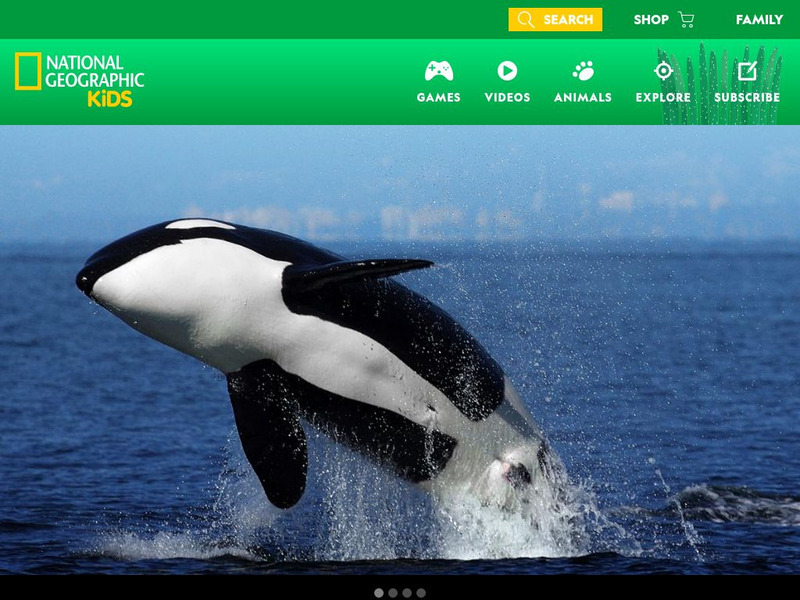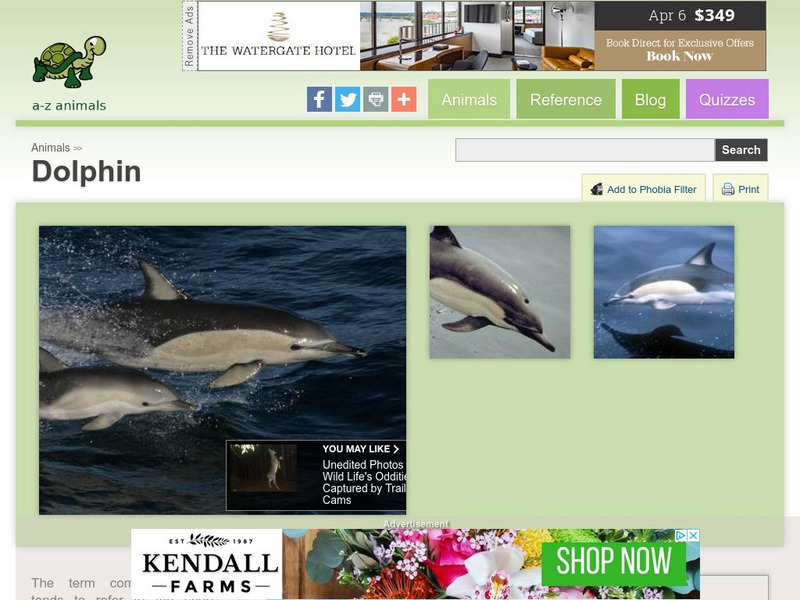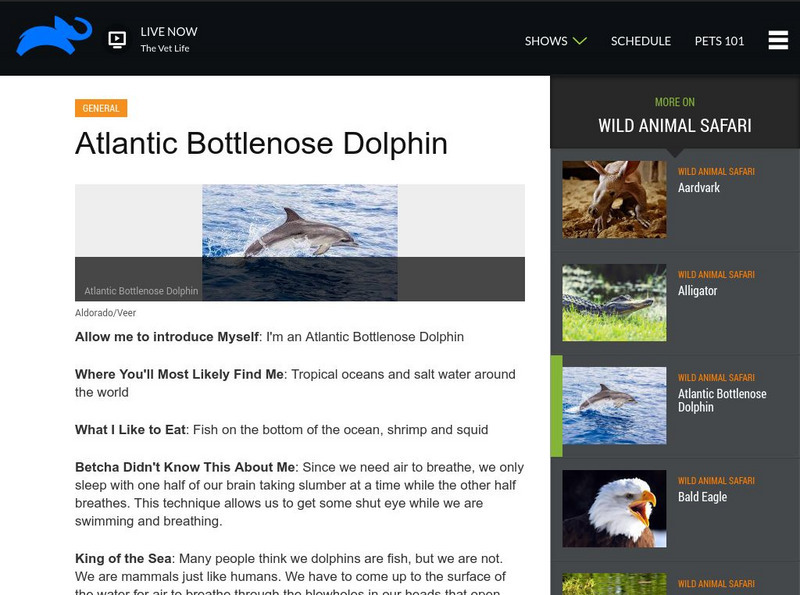Scholastic
Scholastic: Ocean Life: Earthwatch Field Sites (Sea Turtles & Dolphins)
Discover the field sites scientists have visited to study sea turtles and dolphins. Read their reports and view pictures of the turtles and dolphins to learn all about these mammals.
National Geographic Kids
National Geographic Kids: Animals: Orcas
Orcas, more commonly known as killer whales, are featured on this multimedia site. These video clips, audio clips, photographs and facts will be very beneficial to students doing research projects.
Scholastic
Scholastic: Wild Animal Watch Dolphins
An informative site about dolphins by Scholastic. Great links to activities and games, other web links about dolphins and a teacher page.
Scholastic
Scholastic: All About Dolphins
Dolphin expert Dan Odell answers basic questions about dolphins and their lives.
American Museum of Natural History
American Museum of Natural History: Ology: Moving Mammals
Students explore the different ways mammals move by observing them walk, hop, gallop, swim and swing in animations. Facts about habitat and structure are also included in these animations.
Wikimedia
Wikipedia: Dolphin
Wikipedia, a free and open-source encyclopedia, provides a detailed overview of dolphins. Content includes a focus on dolphin taxonomy, the evolution of dolphins, dolphin anatomy, dolphin behavior, feeding, dolphin lore, and more.
Society for Science and the Public
Science News for Students: Sleepless at Sea
Can you go for a month without sleeping? Most mammals can't, but scientists have found some marine mammals that do. Find out why some orcas and dolphins don't sleep for weeks at a time.
PBS
Pbs Teachers: Patagonia: The Truth About Killer Whales
Identify the habitat, range, food sources and behavior of killer whales in Patagonia, identify male and female killer whales and construct a life-sized model of a male killer whale.
Quia
Quia: Animal Facts Scavenger Hunt
At this website you are given ten questions to answer and links to three websites where you can find those answers.
Defenders of Wildlife
Defenders of Wildlife: Keep America's Tuna Dolphin Safe
This site not only contains fact sheets on the bottlenose, spinner, and spotted dolphins, but also examines the whole issue of dolphin conservation. You will learn how tuna fishing is hazardous to dolphins and how eating tuna can be...
BBC
Bbc: Science and Nature: Animals on the Edge Cetaceans
Get information about the risks faced by the Cetacean mammal group. Additional information is also available on the specific species at risk and actions you can take to help.
Smithsonian Institution
Smithsonian National Zoo: Zoogoer Magazine: River Dolphins of No Return
Robin Meadows's article, "River Dolphins of No Return," focuses on the four types of dolphins worldwide that live only in rivers (Amazon River dolphin, Yangtze River dolphin, Indus and Ganges river dolphins).
A-Z Animals
A Z Animals: Animal Facts: Dolphin (Delphinus Delphis)
Offers images, statistics, and a summary of Dolphins with details on their habitat, behavior, and physical characteristics.
Discovery Education
Animal Planet: Atlantic Bottlenose Dolphin
This site provides information about the Atlantic Bottlenose Dolphin including what they eat and how they find food using a process called echolocation.
American Museum of Natural History
American Museum of Natural History: Common Dolphin O Logy Card
Flip this interactive OLogy card and start learning bite-size pieces of useful information about the common dolphin, such as its habitat, diet, and physical characteristics.
Read Works
Read Works: A Family Reunion
[Free Registration/Login Required] An informational text about an orphaned orca named Flipper who was placed with a pod of related orcas. A question sheet is available to help students build skills in reading comprehension.
PBS
Pbs Nature: Dolphin
Explore the world of marine life through the eyes of dolphins when you visit this clear and concise resource. This site features information on where and how dolphins live and other fun facts. Teachers can use this type of site to help...
Other
Neo K12 Education: Marine Animals
Learn about marine animals with fun, interactive, educational videos, games, quizzes, and activities.
Other
American Cetacean Society: Monterey Bay Chapter
This resource provides basic information about educational, conservational and scientific efforts in the Monterey Bay area.
Defenders of Wildlife
Defenders of Wildlife: Dolphin
Topics on this brief site include description, size, lifespan, range-habitat, food, behavior, offspring, and environmental threats.
National Endowment for the Humanities
Neh: Edsit Ement: Under the Deep Blue Sea (Lesson Plan)
Using language and resource skills to explore the ocean and the life within is what this lesson plan from EDSITEment is all about. The lesson is multi-level and resources and academic content standards are available.
Curated OER
Dolphin
Describing some of the reasons that animals make sounds, this website gives concrete examples that make acoustic (auditory) communication easy to understand.
Curated OER
Language Guide: Los Animales Del Mar
Colorful pictures of sea animals interact with audio and the written vocabulary word as you move your mouse over the picture. This vocabulary would compliment a science unit on marine life.






















